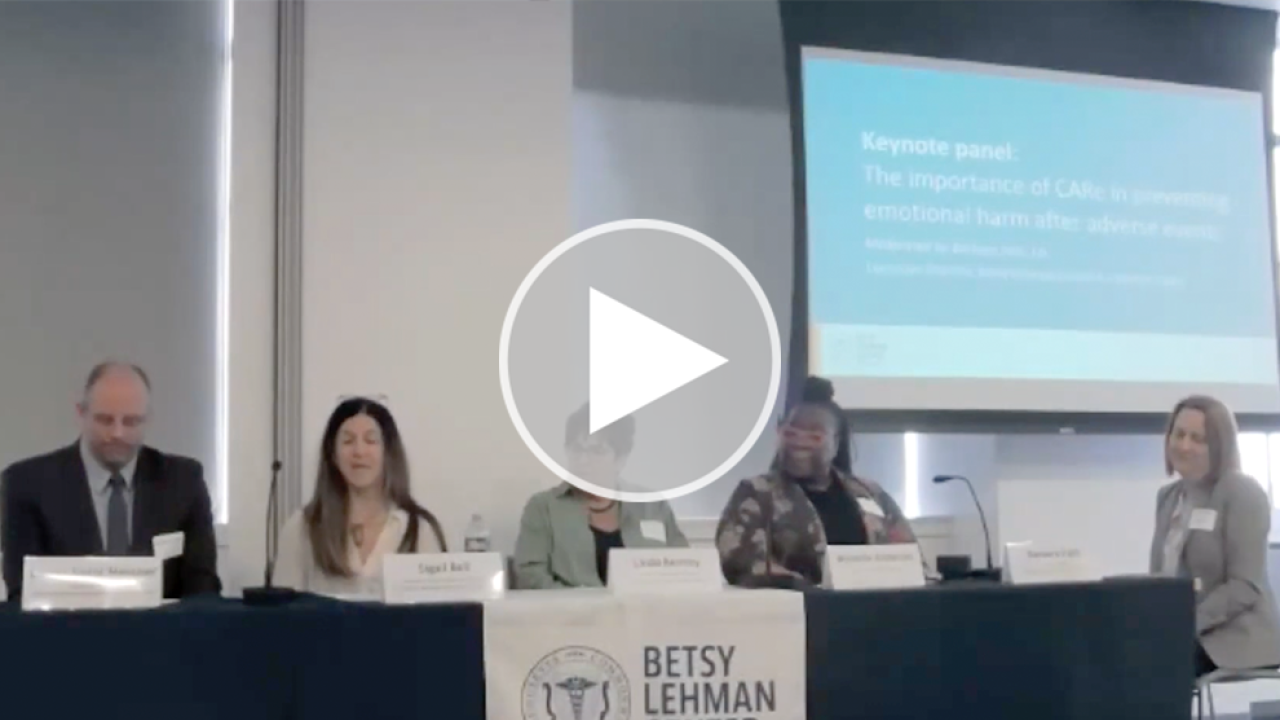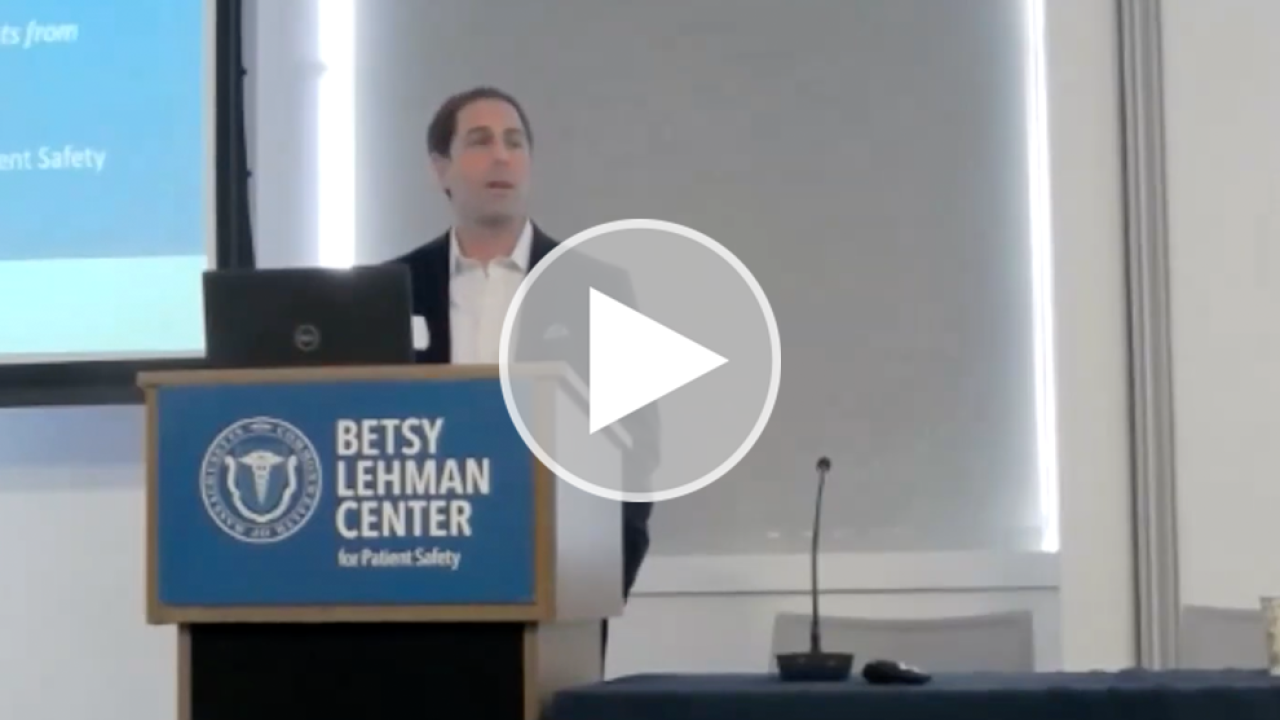CARe Forum: Study underscores role of open communication in patient recovery from harm events
A leading expert on communication and resolution programs says CRPs are key tools for preventing further harm to patients and their families following adverse events.
“I’ve come to realize that poor communication and lack of follow-up after adverse events or unexpected outcomes are safety risks in and of themselves,” said Lauge Sokol-Hessner, M.D. “Impacts are long-lasting, taking a toll on patients’ health, mental well-being, finances, and many other aspects of their lives.”
Dr. Sokol-Hessner was the keynote speaker at the 11th annual CARe Forum in Boston last week, organized by the Betsy Lehman Center. CARe is a CRP model that has gained momentum in Massachusetts over the last decade.
Additional highlights of this year’s forum included:
- Video simulations illustrating opportunities to improve communication with a patient who was harmed.
- A panel of practitioners and patients discussing recent research by Dr. Sokol-Hessner and several Boston-based safety researchers on the role of communication in mitigating emotional harm.
- A Q&A session with safety leaders on ways to improve interactions with patients and their families following an error in their care.
I’ve come to realize that poor communication and lack of follow-up after adverse events or unexpected outcomes are safety risks in and of themselves.
Dr. Sokol-Hessner, M.D., who is a hospitalist and Clinical Associate Professor of Medicine at the University of Washington Seattle, Associate Director of the UW Medicine Collaborative for Accountability and Improvement, and a faculty coach for Ariadne Labs’ Pathway to Accountability, Compassion, and Transparency (PACT) Collaborative, reviewed findings from a 2024 study he co-authored that explores the effect organizational communication can have on patients’ emotional experience after harm has occurred.
The researchers found that more than half of U.S. patients who self-reported a harmful medical error in a survey said the emotional impact was prolonged (30.8% lasting at least a month and 20.4% lasting a year or more).
And those who received no communication or poor communication about the event from the provider or organization were 4.5 times more likely to have emotional impacts lasting more than one year.
Those results are consistent with findings from a 2019 Betsy Lehman Center study demonstrating that open communication from providers about a harm event can reduce emotional impacts and health care avoidance behavior by patients.
Following his keynote presentation, Dr. Sokol-Hessner was joined in discussion by one of his co-authors, Sigall Bell, M.D., Director of Patient Safety and Discovery at OpenNotes; Linda Kenney, Director of Peer Support Programs at the Betsy Lehman Center; and patient advocate Michelle Anderson, R.N.
“As clinicians, we’re trained to deal with problems in front of us,” said Dr. Bell. “Because the emotional impact of adverse events is prolonged and happens outside of our hospital walls, it is much harder to see. You can’t see the patient who doesn’t show up for care because they’ve lost trust in our health care system.”
Asked for her reaction to the studies’ results, Kenney said, “None of this surprises me. I'm glad we now have data to prove it.” She pointed out that the emotional impact of adverse events on clinicians has been studied more than the impact on patients and families. “We need to do better,” said Kenney.
Anderson added that a harm experienced during her care affected her ongoing relationships with providers and the health care organization. “You shattered my belief that you are here to provide me with something that's going to improve my existence. Now I don’t have confidence in that because I don’t have trust,” she explained.

Keynote presentation and panel
Dr. Sokol-Hessner drew an analogy between CRPs and earlier assumptions about other patient safety challenges, such as central line-associated blood stream infections. “We learned that we could prevent CLABSIs with a ‘bundle’ of actions, and now what was a patient safety intervention has become the standard of care.” He expects that CRPs are on a similar arc of progress. “We've innovated CRPs, and there's still room to grow and make them better. But we know they work; they decrease harm,” he said.

Case simulation and panel discussion
Case simulation helps organizations learn how to improve CARe
Forum participants also watched a video simulation of a recent CARe case, followed by a discussion with a panel of CARe practitioners.
Van Niel, who moderated the panel, emphasized that “Every case is different, every patient is different, and every case is a challenging situation. It is OK if the process doesn't go 100% right as long as we're continuously learning. We want to demonstrate that mistakes in the CARe process can be recovered.”

Closing remarks
Dr. Bell made similar remarks about the downside of aiming for perfection in difficult communications. “People are so afraid of saying the wrong thing that they say nothing at all,” which compounds the problem, she noted.
CRPs can benefit physicians as well as patients and families
Drs. Sokol-Hessner, Bell and Peter Smulowitz, Chief Medical Officer of Milford Regional Medical Center, all commented that CARe can also help physicians refocus on why they went into medicine in the first place, which may seem counterintuitive. Dr. Sokol-Hessner said, “When something really bad happens, our job doesn’t end, it is that much more important. It's a special opportunity to really step up to the moment and meet the needs for care, with benefits for providers as well as patients and families.”
In closing remarks, Dr. Smulowitz, who co-chairs the Center’s CARe advisory body, cited an error he made as a young physician that stays with him today and urged those in the room to continue their CARe work. “CRPs are the #1 operational thing that should be done in quality and safety,” he said. “This work ties it all together.”